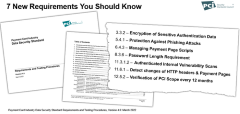

A Checklist for Choosing the Best Payment Gateway for Recurring Payments
Here's what to look for when researching your next payment gateway
Work with a payment gateway provider that is flexible enough build the solution that will work best for your business
We’ve put this checklist together to help you understand what to look out for when choosing or evaluating a payment gateway. Businesses that are subscription based or process recurring payments should look to partner with a gateway company that has experience in subscriptions so they can provide the tools necessary to set-up recurring payments, such as scheduling.
Security
- When it comes to taking payments and choosing the best payment gateway for recurring payments, security and compliance are critical! Many online retailers don’t realize they – like their brick-and-mortar counterparts – are required to meet standards set by the Payment Card Industry Data Security Standard. The simplest way to ensure your customer is protected is to partner with a company listed as a Point-to-Point Encryption provider. This way you can verify the gateway is both certified and PCI-compliant.
Features
- You should also look for gateways that can handle multiple payment methods. This goes beyond your typical charge and credit cards. Consumers are demanding more access to payment methods and your customers will have to be ready to support them. Having options such as Apple Pay and Google Pay wallet opens the door to more customers.
- Account Updater should be one of their key features – it queries the banks regularly to ensure the card data is correct, cutting down on decline rates and reducing churn.
- Same goes for Automated Level 3 processing. It autodetects and fills in information necessary for corporate and procurement cards to process at a lower interchange rate – oftentimes leading to significant savings.
- Another feature to look for is Direct Debit ACH scheduling – it allows merchants to get paid directly from a customer’s bank account, and they, in turn, pay less in processing fees.
Pricing
- Most payment gateways offer an all-in-one bundled rate for the gateway and the merchant account service. Companies usually advertise 2.9% plus 30 cents a transaction. This model seems pretty straightforward and is convenient . However, not all gateways require you to sign up with their merchant in order to get the gateway. Look for a provider that is are system agnostic and can code their gateway to any acquirer or processor. Your customer can bring their own processor on board or, they can work with the gateway provider to get one. There are many advantages to this set up. You’ll also benefit from cost-plus pricing instead of a bundled pricing.
Developer & Customer Support
- When you’re checking out potential gateway partners, ask them about integration. How many systems are they connected to and what platforms do they support? Do they have documentation and a development environment? What platform do they use for their API? If it’s a common one, like RESTful web service, then set up and testing is fairly easy.
- If you’re moving a customer from one provider to another, migration should be as easy and seamless as possible for everyone involved. It should include a secure transfer of all account information. Also, consider timing implications, as you want to minimize disruptions for your customers.
- Make sure to ask about their customer service and technical support. Problems happen, and how quickly they’re resolved makes a big difference to customers. When vetting a company, check to see where their support team is located. Ask if you’ll receive personalized service, or will you be re-directed through a series of menus. The more time spent on calls is less time you have to serve your customers.


